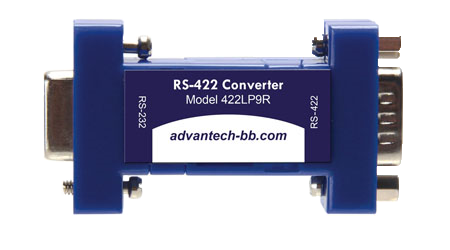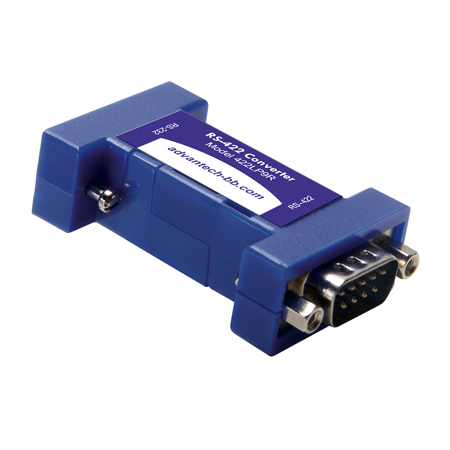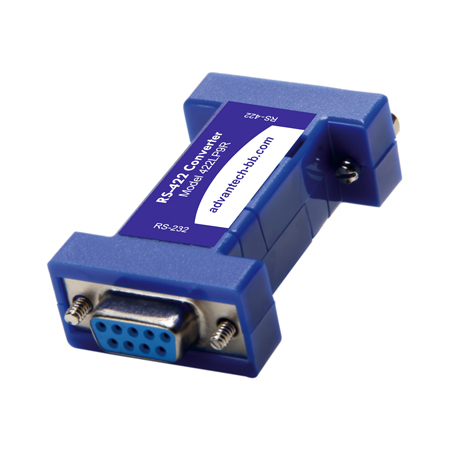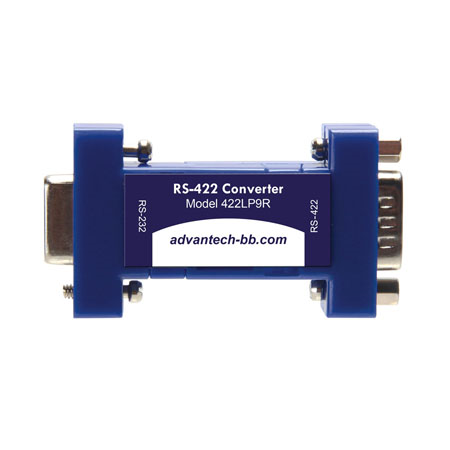Advantech BB-422LP9R
Port-Powered RS-232 to RS-422 Converter - DB9F/DB9M





- Converts RS-232 TD and RD to balanced RS-422 signals
- Baud rate up to 115.2 kbps; extends data up to 1.2 km (4000 ft)
- Inline installation
- FCC, CE certifications
- Port-powered from RS-232 handshake lines (RTS, DTR)
- 4.7K Ohm biasing resistors
Model 422LP9R is a port-powered, two-channel RS-232 to RS-422 converter. It converts TD and RD RS-232 lines to balanced RS-422 signals. The unit is powered from the RS-232 handshake lines DTR and RTS.
OPERATION TIPS
Model 422LP9R is powered from the RS-232 handshake lines DTR and RTS. One of these handshake lines must be asserted (high) in order to power the unit. (See Table 1). The RS-422 driver is enabled when RTS is asserted. RTS must be asserted in order to transmit data. The RS-422 receiver is always enabled. If DTR is always asserted and the RTS is used to control the driver, Model 422LP9R can be used as an RS-232 to RS-485 4-wire converter. To ensure reception, it is recommended that DTR is asserted. In order to maximize the amount of power available to the RS-422 driver, the RS-232 handshake lines are not looped back (tied together). As a result, the following handshake lines will appear as disasserted (low): CTS, DCD, and DSR. Care should be taken to ensure that any software being used does not require any of these handshake lines be asserted. If existing software requires any of the handshake lines to be asserted, you can loop back the required handshake lines in your cable.
Connections
Model 422LP9R can be connected in three different type of systems: RS422 (Figure 1), four-wire RS-485 (Figure 1), and two-wire RS-485 (Figure 2). Regardless of the system, Model 422LP9R must be connected with the proper polarity. With no data is being sent and the driver enabled, the RS-232 line should be negative and TD(A) should be negative with respect to TD(B).
Proper operation of any RS-422 system requires the presence of a signal return path between the signal grounds of the equipment at each end of an interconnection. This circuit reference may be established by a third conductor connecting the common leads of devices, or it may be provided by connections in each piece of equipment to an earth reference. When the circuit reference is provided by a third conductor, the connection between the signal grounds and the third conductor should contain some resistance (e.g. 100 Ohms) to limit circulating currents when other ground connections are provided for safety.
Biasing Resistors
The RS-422/RS-485 receiver biasing resistors are 4.7K Ohm resistors. The resistors are labeled R1 and R6 (see Figure 3). Refer to B+B SmartWorx RS422/485 Application Note for more information on biasing (available on website).

OPERATION TIPS
Model 422LP9R is powered from the RS-232 handshake lines DTR and RTS. One of these handshake lines must be asserted (high) in order to power the unit. (See Table 1). The RS-422 driver is enabled when RTS is asserted. RTS must be asserted in order to transmit data. The RS-422 receiver is always enabled. If DTR is always asserted and the RTS is used to control the driver, Model 422LP9R can be used as an RS-232 to RS-485 4-wire converter. To ensure reception, it is recommended that DTR is asserted. In order to maximize the amount of power available to the RS-422 driver, the RS-232 handshake lines are not looped back (tied together). As a result, the following handshake lines will appear as disasserted (low): CTS, DCD, and DSR. Care should be taken to ensure that any software being used does not require any of these handshake lines be asserted. If existing software requires any of the handshake lines to be asserted, you can loop back the required handshake lines in your cable.
Connections
Model 422LP9R can be connected in three different type of systems: RS422 (Figure 1), four-wire RS-485 (Figure 1), and two-wire RS-485 (Figure 2). Regardless of the system, Model 422LP9R must be connected with the proper polarity. With no data is being sent and the driver enabled, the RS-232 line should be negative and TD(A) should be negative with respect to TD(B).
Proper operation of any RS-422 system requires the presence of a signal return path between the signal grounds of the equipment at each end of an interconnection. This circuit reference may be established by a third conductor connecting the common leads of devices, or it may be provided by connections in each piece of equipment to an earth reference. When the circuit reference is provided by a third conductor, the connection between the signal grounds and the third conductor should contain some resistance (e.g. 100 Ohms) to limit circulating currents when other ground connections are provided for safety.
Biasing Resistors
The RS-422/RS-485 receiver biasing resistors are 4.7K Ohm resistors. The resistors are labeled R1 and R6 (see Figure 3). Refer to B+B SmartWorx RS422/485 Application Note for more information on biasing (available on website).

SPECIFICATIONS
| SERIAL TECHNOLOGY | |
| Data Rate | 115.2 kbps maximum |
| RS-232 Connector | DB9 female RS-422 |
| Connector | DB9 male |
| Biasing Resistors | 4.7k Ohms |
| POWER | |
| Power Source | Port-powered from RS-232 handshake lines |
| MECHANICAL | |
| Dimensions | 6.2 x 3.3 x 1.1 cm (2.4 x 1.3 x 0.43 in) |
| Enclosure | Plastic |
| Weight | 81.6 g (0.18 lb) |
| MEANTIME BEFORE FAILURE (MTBF) | |
| MTBF | 3020199 hours |
| MTBF Calc. Method | MIL 217F Parts Count Reliability Prediction |
| ENVIRONMENTAL | |
| Operating Temperature | 0 to +70 °C (+32 to +158 °F) |
| Storage Temperature | -40 to +85 °C (-40 to +185 °F) |
| Operating Humidity | 0 to 95% non-condensing |
| APPROVALS / CERTIFICATIONS | |
| FCC, CE | |
| 2014/30/EU | Electromagnetic Compatibility Directive |
| 2011/65/EU | Reduction of Hazardous Substances Directive (RoHS) |
| 2012/18/EU | Waste Electrical and Electronic Equipment (WEEE) |
| EN 55032 Class A | - Electromagnetic Compatibility of Multimedia Equipment - Emission Requirements |
| EN 55024 | - Information Technology Equipment - Immunity Characteristics - Limits and Methods of Measurement |
| EN 61000-6-4 + A1 | = Generic Emission Standard for Industrial Environments (Class A) |
| EN 61000-6-2 | - Generic Immunity Standard for Industrial Environments |
 Customers who viewed this item also viewed
Customers who viewed this item also viewed













 Properties
Properties Description
Description Further Information
Further Information



 Properties
Properties Description
Description PDF
PDF